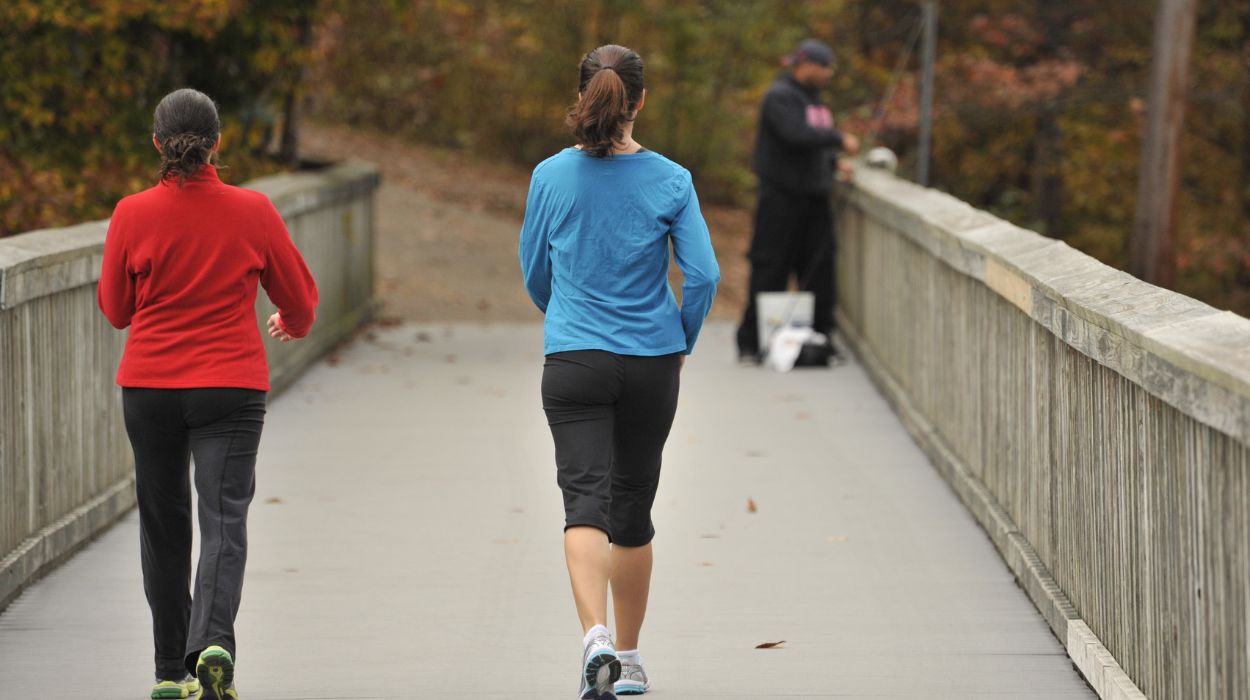In the world of weight loss, simple activities like walking are often overshadowed by high-intensity workouts, strength training, and complex diets. This means that questions like “How many steps a day to lose weight?” are often dismissed.
However, it shouldn’t be, as research shows that walking may help you burn[1] extra calories and develop lean muscle. Let’s put one foot ahead of the other and find out how many steps you must take daily to lose weight below.
How Many Steps In A Day To Lose Weight?
To lose weight with steps:
- Aim for 10,000 steps per day, equivalent to roughly 5 miles.
- You can start gradually with just 1000 extra steps a day and build up to 10,000 steps.
- Increased step counts are linked to weight loss and better mental and physical health, which supports weight maintenance.
How Many Steps A Day To Lose Weight?

Walking For Weight Loss
The exact number of steps you need to take for weight loss depends on individual factors like age, gender, diet, and more. However, studies have reported positive effects from walking 10,000 steps daily.
Those who walked 10,000 steps daily[2] for 18 months paired with a calorie-restricted diet had 10% weight loss. The intensity of the steps varied, with approximately 3,500 being moderate-to-vigorous and spanning ten continuous minutes.
Lowered Mortality, Better Health
Walking more steps is also linked to a lower risk of dying[3] from various causes. A 7-year-long study found that those taking more daily steps had lower heart disease and cancer incidents. The benefits were noticeable up to the 10,000 steps mark.
This suggests that walking more positively impacts weight loss and general health and reduces the risk of developing serious illnesses.
Start Slow
A review of 17 studies found that an increase of just 1,000 steps daily[4] lowered the risk of all-cause mortality and cardiovascular disease morbidity. This means a lower risk of premature death from conditions like high blood pressure, blood sugar, and heart disease.
Resting energy may increase by 4.8%[5] per day from increased walking, which can also benefit weight loss. So, swapping out a sedentary posture for a walk can provide overall health benefits beyond weight loss.
Why Is Exercise Important For Weight Loss?

Most weight loss comes from eating fewer calories. A calorie-restricted diet is like controlling the amount of fuel (calories) you put into your body. Instead of eating as much as you want, you purposely eat less than your body needs.
This helps your body use stored energy (fat stores), leading to weight loss. Research suggests regular exercise is the only way to maintain weight loss.[6] So, exercise is a key player in weight loss journeys.
Exercise helps us burn the calories we eat through physical activity. This creates a seamless cycle of weight loss and maintenance. An overview of reviews summarizing the effects of exercise on weight loss[7] found that exercise training improves body weight and body composition in obese and overweight participants.
Reductions in body fat and visceral (abdominal) fat were also noted. This can positively impact heart health[8] and support better fitness goals. Below, we look at other reasons why exercise is important for weight loss:
Burns Calories
Engaging in resistance,[9] cardiovascular,[10] or aerobic exercise increases the calories you burn. This leads to fat loss and reduced waist circumferences. The more you exercise, the higher the caloric expenditure and weight loss.
Intense physical activities require more energy. So, the body burns more calories to sustain the increased effort. Running on a treadmill or intense weightlifting are high-intensity workouts that tend to lead to greater calorie burns than lower-intensity activities like walking or gentle stretching.
The Creation Of A Caloric Deficit
Weight loss hinges on achieving the perfect balance between what we eat and what we do. Diet and exercise work hand in hand to create a calorie deficit. This is when the body uses more calories than it gains through the food we eat.
If you’re wondering how many calories to eat to create the deficit, the answer is in diet plans[11] and weight loss strategies. These will help you stay on track with the amounts and types of food you eat. Generally, individuals need about 30-35 kcal/kg[12] of ideal body weight to maintain a healthy weight.
Online calculators are ideal for determining baseline calorie needs. When it comes to the exercise part of the deficit. You can start with a simple, moderate exercise routine that includes activities like a daily walk.
To maximize the effectiveness of walking for a calorie deficit, you can:
- Aim for at least 150 minutes of moderate-intensity[13] aerobic activity per week, as health guidelines recommend.
- Increase the intensity of different exercises. For example, the intensity of walks can be increased by walking uphill, briskly, or even 10,000 steps. Moderate intensity is defined[14] as 64%-76% target heart rate. This is determined by an age-adjusted formula of 220-age=maximum heart rate x percentage.
- Be consistent. Daily walking or exercise, even if it’s just for 30 minutes, can add up over time.
Regular exercise contributes to the deficit by increasing energy expenditure. It prompts the body to use stored energy to meet its needs. This results in weight loss.
Elevated Resting Metabolic Rate And Preservation Of Lean Muscle Mass
Exercise not only burns calories through the activity but can also have a lasting impact on your resting metabolic rate. Regular physical activity, especially strength training[15] and high-intensity exercises, can contribute to developing and maintaining lean muscle mass.
Muscle tissue is metabolically active – it consumes lots of energy and calories. Having more muscle can lead to an increased RMR.[16] This means that even when you’re not actively exercising, your body continues to burn more calories at rest. This leads to a lower body fat percentage-weight loss.
Appetite Regulation
While the relationship between exercise and appetite is complex, regular physical activity is associated with better appetite control. This is because exercise positively affects hormones that regulate appetite.[17]
The effect of these hormones improves adherence to a calorie-restricted diet, so you don’t eat more calories than you need–weight loss. Exercise also encourages you to drink water, which further helps appetite regulation and weight loss.[18]
Mental Health
Physical and mental health are positively affected during exercise. Emotional well-being[19] plays a significant role in weight management. It can influence eating habits and adherence to a healthy lifestyle.
Exercise helps lessen depressive and anxious moods,[20] which provides a more solid base for weight loss.
How To Calculate Steps Per Day
Set Goals
Set a daily step goal. While the standard recommendation is walking 10,000 steps a day. It may be challenging if you’re used to a sedentary lifestyle. Begin with a more attainable number and progressively raise it to avoid feeling overwhelmed.
Understand Baseline Activity
While walking 10,000 steps may be the gold standard, it may vary for each individual depending on how active you are in general. Below is the recommended number of steps[21] based on how much you move around on a typical day:
| Activity Level | Steps Per Day |
| Basal | Below 2,500 |
| Limited | 2,500 – 4,999 |
| Low | 5,000 – 7,499 |
| Somewhat active | 7,500 – 9,999 |
| Active | 10,000 – 12,499 |
| Very active | Over 12,500 |
Counting Steps
To keep track of your steps, use a pedometer or a smartphone app. Smartphones typically have built-in step counters or access to downloadable apps dedicated to tracking your daily steps. This works like a “How many steps a day to lose weight” calculator. Make sure to keep your device with you throughout the day.
Measure Routine Steps
Take note of how many steps you take on a typical day to see if you’re on track with how many steps per day you need to take to lose weight. This includes walking in all forms, from walking to your office to climbing stairs or strolling around the park. These steps are already part of your daily activity, so including them in your overall step count is essential.
Add Purposeful Steps
To reach your daily goal, intentionally add more steps to your routine. Consider taking short walks during breaks, parking your car farther away, or opt for the stairs instead of the elevator. Small changes or planned inefficiencies can make a big difference.
You also need to listen to your body. If you’re feeling fatigued, it’s okay to take it easy. The goal is to incorporate more movement into your day, not to push yourself to exhaustion.
Conclusion
Walking is a simple yet effective weight loss approach that can help reduce the numbers on the scale and improve your health.[22] If you’re wondering how many steps you should take to lose weight, start counting today.
The answer can vary depending on several factors, such as age, gender, and dietary habits. However, the 10,000 steps a day theory has proven to be more than just a catchy number, making it a viable guide.
Science has highlighted the positive effect of walking 10,000 steps on weight loss. You can start slow and vary the intensity of your steps while keeping track of your heart rate and step count. Also, incorporate daily exercise into your lifestyle.
While walking is beneficial, you can also follow a controlled diet or use supplements like a nighttime fat burner and diet pills for additional support. However, you must consult a medical professional before using supplements, especially if you have known allergies, are on medication, have a health condition, or are sensitive to chemicals.
Frequently Asked Questions
Yes, they have. However, you must remember the steps alone are not a surefire way to lose weight. Walking needs to be paired with a balanced/controlled diet.
Yes, it can. Walking promotes overall weight loss, and belly fat loss[23] is part of that process. You can also add a belly fat burner to your walking regimen for better results.
Walking 10,000 steps a day, combined with a healthy diet, can lead to a loss of around 1-2 pounds per week if a calorie deficit of 500-1,000 per day is maintained. Results may differ based on individual factors.
This depends on your weight loss goals and capabilities. While achieving 10,000 steps every day may lead to weight loss, combining it with other exercises can further enhance your overall weight loss results.
 Evidence Based
Evidence Based

